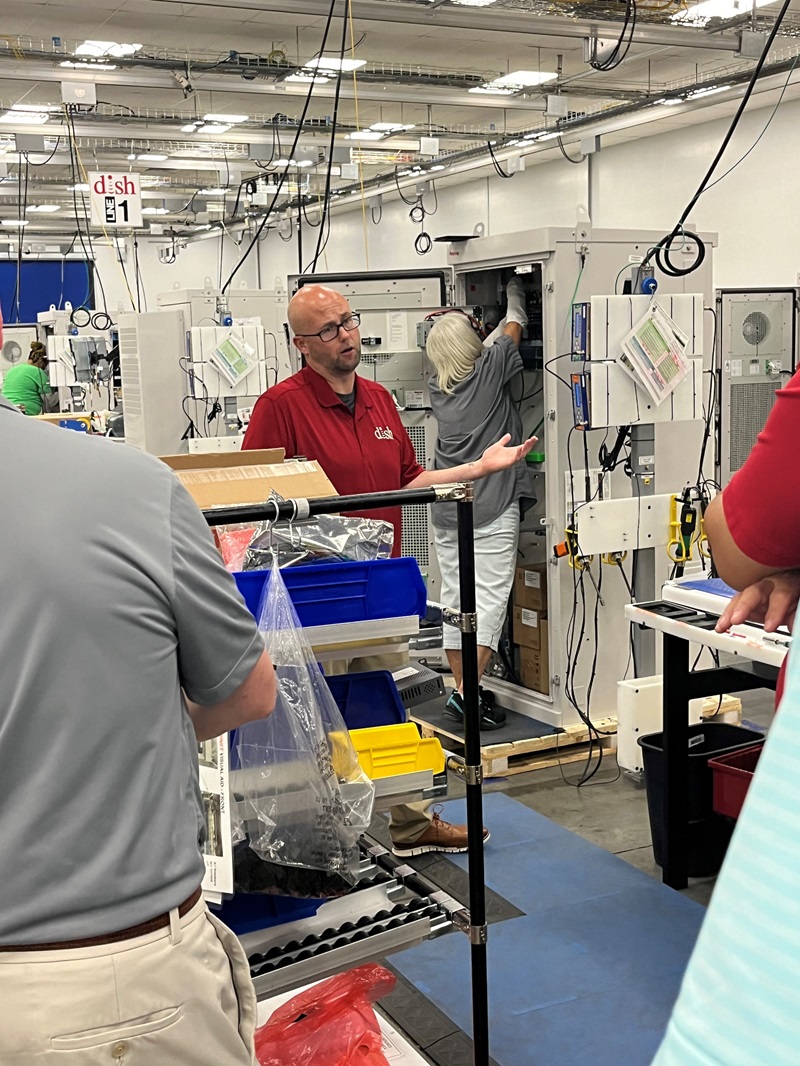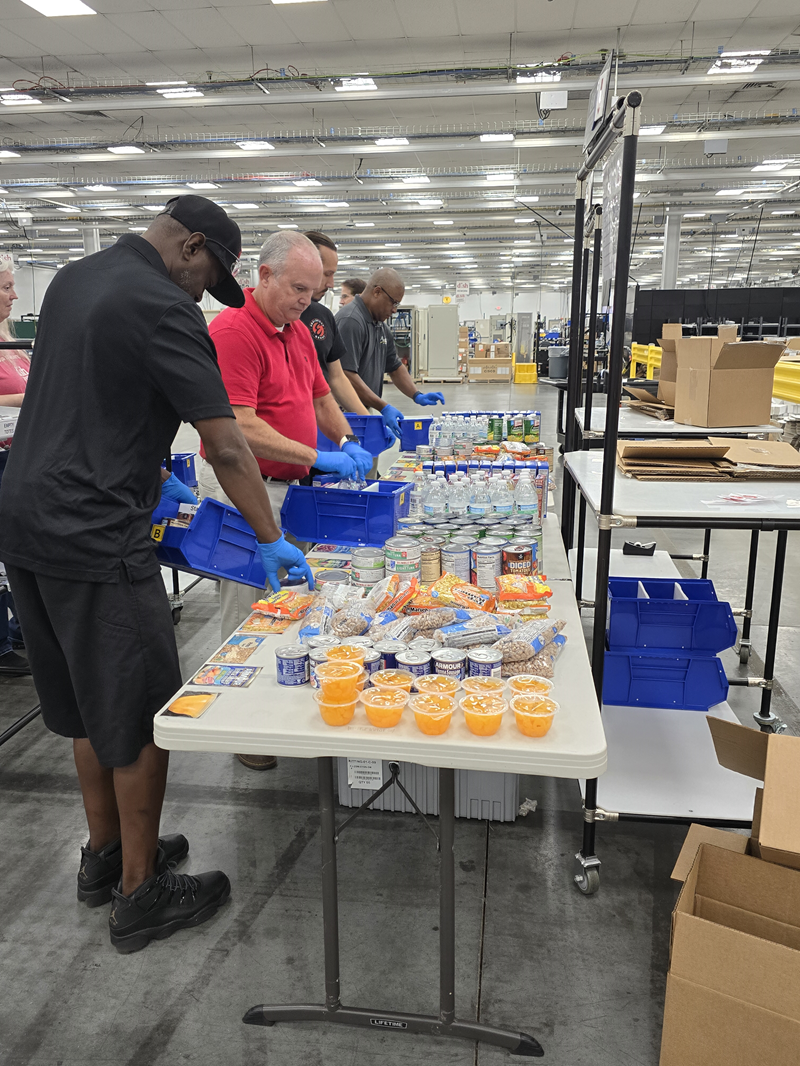As the leader of the OpExChange for the SCMEP, my mission is to foster collaboration and the sharing of best practices among manufacturers in South Carolina. Our most recent plant visit took us to Dish Network’s Spartanburg facility, where thirty-three participants from ten counties and twenty-two companies gathered to learn and engage.
This visit was particularly special to me, as I had the privilege of working at this very site for ten years, starting in 2006 when the plant was first constructed. Today, the 317,000 square foot facility stands as a fantastic example of successful change management, having undergone significant transformations. Originally a high-volume, high-mix single-piece flow operation, it evolved into a low-volume, high-mix facility, specializing in the production of large cabinet enclosures for Dish’s nationwide 5G rollout. They are now venturing into expanding from strictly a cost center within the company to a revenue generator for Dish.
Dish Spartanburg’s success in these transitions is largely attributed to its culture, nurtured over eighteen years, with an average tenure of nearly fourteen years among its team members. The facility’s leadership embodies Dish’s mantra: “Do It SomeHow!” This philosophy underscores a deep belief in the power of their workforce, emphasizing continuous learning, development, and a never-say-never attitude towards challenges. Lean manufacturing and employee engagement are deeply embedded in the foundation of this culture.
Sean Summey, the General Manager, Brian Harris, Senior Operations Manager, and Mela Ly, the Continuous Improvement Manager, guided us through portions of this visit. Brian provided an insightful overview of Dish’s history at the site, while Sean and Brian led the group on a comprehensive tour of their production operations. Mela then facilitated a spectacular hands-on lean simulation, demonstrating to the OpExChange visitors how Dish trains new hires to understand lean manufacturing concepts and waste elimination.
Currently, Dish Spartanburg is taking on a new challenge – transforming its operations from a traditional cost center into a revenue-generating entity. Their engineering and manufacturing teams have developed significant expertise in cable and electrical harness operations, utilizing their lean mindset to design processes that prioritize safety, quality, and cost efficiency. Now, they are planning to leverage this expertise to bring value to other companies.
Developing Lean Prowess
When the plant opened in 2006, it quickly grew into a high-volume, low-mix reverse logistics center for Dish, employing up to 1,300 people within three years. During this growth, they concurrently began developing their lean manufacturing capabilities. They joined the OpExChange in 2007, and have been active participants, sending managers, engineers, supervisors, and operators to learn from other sites and take back best practices to Dish. They have also given back to the OpExChange community, benchmarking and sharing with others what they have learned.
Dish also has an in-house lean six-sigma belt program, led by Mela Ly. Currently, about one-third of their workforce has been through this training earning a green belt, black belt, or master black belt. Notably, this includes hourly employees who will lead Kaizen projects to make improvements at the facility. They also include a four-hour lean simulation in their thirty-seven-hour onboarding training. This commitment to continuous improvement was instrumental in their journey. Dish is well respected among OpExChange peers for their visual manufacturing and demonstration of lean principles.
Exploring the Production Operations
At the heart of every cell tower in Dish’s 5G infrastructure are the cabinet enclosures produced in Spartanburg. Sean and Brian divided the group into two and guided the tour. Over the past three years, the Spartanburg plant has built over 650 different cabinet configurations. Sean emphasized that because they are producing these in-house instead of outsourcing, they can be nimble in handling complex customizations efficiently. Each of these is built-to-order.
Throughout the floor, the visual organization of their operations was clear and organized with shadow boards to simplify work processes, visual aids to guide associates in assembly, and clear floor demarcations for both safety and workflow. These highlighted Dish’s commitment to employing lean principles.
Weekly 5S audits are conducted by operators from different work areas, ensuring sustained safety, quality, and productivity. The visual check sheets are displayed at each workstation.
Cable and Wire-Harness Assembly
The cable area is a prime example of Dish’s innovation. Initially, they found in-house cable assembly to be significantly cheaper than outsourcing for the cabinets. With two automated rotary cable strippers, they enhanced safety and consistency, producing high-quality cable cuts and insulation stripping. “The most critical part of the cable is not the center, but the exterior,” Sean explained to the group. AC current typically flows near the surface of the conductor, so any cuts or scores in the cable can disrupt this flow, increasing resistance and causing localized heating, which can lead to failure. To avoid the inconsistencies from manual stripping, their automated process ensures consistent, high-quality results. This process repeatability pays off not only in efficiency but also in equipment reliability in the field.
They have also applied their engineering ingenuity at Dish to enhance several tools used in cable assembly. Sean demonstrated improvements made to an off-the-shelf crimper, including added guarding to prevent injuries and simple vertical adjustability to accommodate associates of different heights. The supplier of this equipment plans to incorporate these modifications into their product design.
In a two-month project last year, a Clemson intern developed a process for in-house manufacturing of a large cable used on top of cell towers, saving Dish over $2 million annually. This intern, now a full-time Dish Electrical Engineer, exemplifies the practical impact of their deployments.
As they developed their internal processes, equipment and material suppliers began telling Sean that Dish’s operations rival some of the best cable and harness assembly operations they have seen and suggested he consider entering this business. When Sean recognized the significant savings from insourcing the large cable assembly, he knew it was time to explore this new venture.
The group gained insight into the intricate process of their first outsourced harness assembly. To provide additional expertise, Brian Harris brought in manufacturing and design engineer, Jimmy Pollard. Collaborating closely with their initial customer, the team not only met expectations but also enhanced the harness design for improved reliability and cost-effectiveness. This complex assembly, comprised of five sub-assemblies, spans thirty-one feet and incorporates thirty-four distinct cable components.
Jimmy explained the process design for the harness, emphasizing built-in error prevention, continuity, and quality checks. He beamed with pride as he talked about their cable operations. “You won’t find anyone out there that is doing what we are doing,” he exclaimed. Early production challenges arose from inconsistent wire insulator diameters, causing cable jams in the automated stripping machines, resulting in equipment damage and process efficiency.
Additionally, insufficient insulation on the cable could result in field failures as well. Unable to find a suitable market solution, the team developed an in-house system equipped with sensors to precisely measure cable diameter. They retrofitted the automated equipment with this solution. Custom software, including upper and lower control limits, monitors the process and halts operations in case of irregularities.
Lean Simulation and Belt Program
The highlight of our visit was the lean simulation led by Mela Ly. Just as Mela was beginning her presentation a Dish Cares community outreach representative interrupted Mela in the middle of her presentation with “an emergency.” She needed thirty food kits for the local family resource center that they support. It shortly became apparent that this was part of the simulation exercise, intended to mimic real-life chaos that occurs in a production environment.
Participants engaged in rounds of simulation, identifying and discussing the seven wastes found in manufacturing, reinforcing the importance of lean principles.
Mela shared that every new Dish employee undergoes a four-hour version of this simulation during their onboarding, earning “Level 1” lean certification. This is part of a thorough, thirty-seven hour on-boarding program.
Although this was an abridged version of the four-hour training performed in-house, participants said it was helpful both in their own personal knowledge and in generating ideas how they can implement something similar at their sites. They were all delighted to learn that the kits they produced would actually be delivered to the Upstate Family Resource Center in Boiling Springs.
Dish’s Lean Leadership Legacy
Since joining the OpExChange in 2007, Dish has hosted four plant visits, each highlighting distinct aspects of their lean journey. From their early focus on lean manufacturing and utilizing advanced manufacturing to their recent strides in agility and innovation, Dish has consistently demonstrated that sustained leadership, lean principles, and employee development yield remarkable results. It is their people and the culture that ultimately allow them to be successful with each new challenge.
The OpExChange program emphasizes knowledge sharing among South Carolina manufacturers to strengthen the overall manufacturing landscape. Dish not only shared its insights with the OpExChange group in this visit but also conducted a deeper-dive session with Savannah River Nuclear Solutions the following week. Despite the distinct nature of their operations, both organizations identified valuable transferable knowledge in lean practices, leadership, and culture development.
I have had the privilege of working alongside many dedicated Dish team members over the years. I am incredibly proud of their accomplishments. The Spartanburg site is poised to become a leading U.S. supplier of cables and wiring harnesses, setting a new standard for manufacturing excellence.
About Dish
EchoStar Corporation, headquartered in Englewood, Colorado, is a key player in telecommunications and satellite industries, housing several brands that have made significant impacts. Its subsidiaries include Dish TV, Hughes Network Systems, Sling, Boost, and Dish Wireless, each contributing uniquely to EchoStar’s success in satellite television, broadband solutions, streaming services, mobile satellite communications, and wireless networking.
Dish TV, a flagship brand, has revolutionized satellite television in the US with extensive programming options and advanced DVR capabilities. Hughes Network Systems specializes in satellite broadband solutions, enhancing global connectivity through HughesNet satellite internet, crucial for education, commerce, and daily communication.
Sling, under EchoStar, leads in over-the-top streaming with Sling TV, offering flexible, subscription-based access to live and on-demand TV. Boost focuses on mobile satellite services for sectors like maritime and aviation, ensuring reliable connectivity in remote areas. EchoStar’s Dish Wireless aims to establish a nationwide Open RAN 5G network, expanding its presence in wireless networking. EchoStar continues to innovate and enhance connectivity globally in satellite technology, telecommunications, digital entertainment, and wireless networking.
About OpExChange
The OpExChange, an SCMEP program, is a peer-to-peer network of manufacturers and distributors in South Carolina known for generating success for members through benchmarking and best practice sharing. Member companies host events and share practical examples of industrial automation, lean manufacturing improvements, and leadership development. It is an invaluable resource to South Carolina companies that provides access to others who are on similar improvement journeys. If your company is interested in participating in this collaborative effort to improve both the competitiveness of your operation and South Carolina, contact Mike Demos (mdemos@scmep.org). More information and upcoming plant visits are available on the OpExChange website www.OpExChange.com.
Content written by
Mike Demos
OpExChange Coordinator
South Carolina Manufacturing Extension Partnership




Be the first to comment on "Harnessing Success: The Power of Lean Culture at Dish Network"